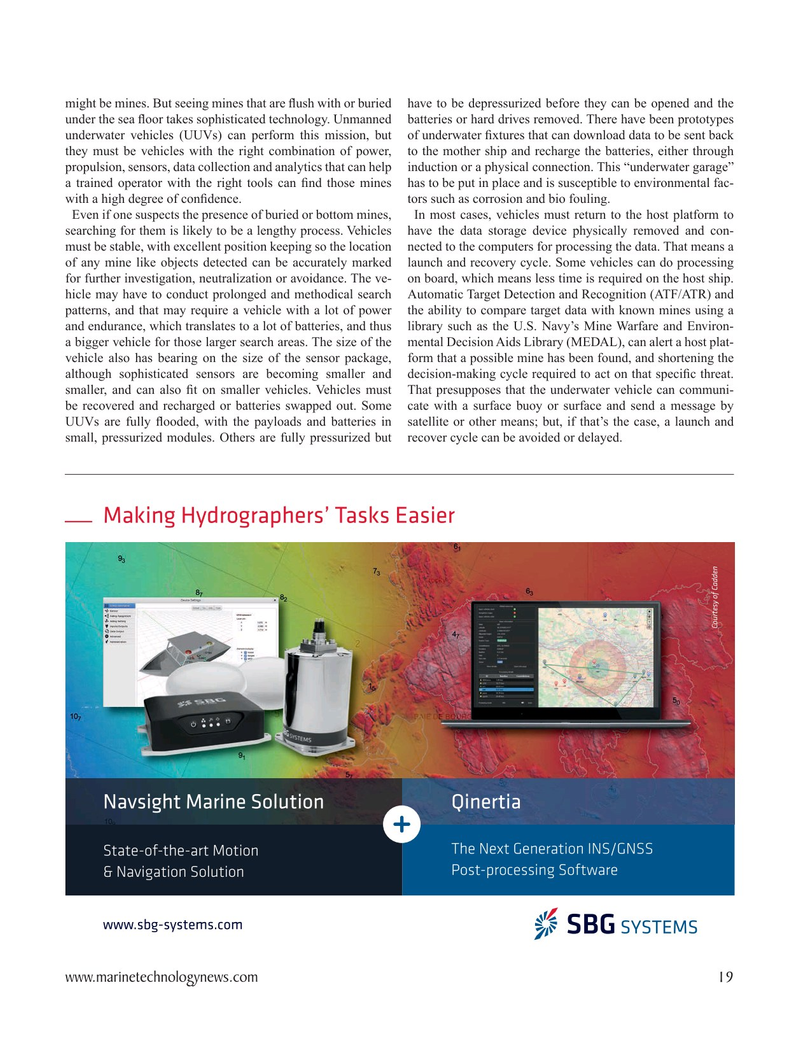
Page 19: of Marine Technology Magazine (January 2022)
Read this page in Pdf, Flash or Html5 edition of January 2022 Marine Technology Magazine
might be mines. But seeing mines that are ? ush with or buried have to be depressurized before they can be opened and the under the sea ? oor takes sophisticated technology. Unmanned batteries or hard drives removed. There have been prototypes underwater vehicles (UUVs) can perform this mission, but of underwater ? xtures that can download data to be sent back they must be vehicles with the right combination of power, to the mother ship and recharge the batteries, either through propulsion, sensors, data collection and analytics that can help induction or a physical connection. This “underwater garage” a trained operator with the right tools can ? nd those mines has to be put in place and is susceptible to environmental fac- with a high degree of con? dence. tors such as corrosion and bio fouling.
Even if one suspects the presence of buried or bottom mines, In most cases, vehicles must return to the host platform to searching for them is likely to be a lengthy process. Vehicles have the data storage device physically removed and con- must be stable, with excellent position keeping so the location nected to the computers for processing the data. That means a of any mine like objects detected can be accurately marked launch and recovery cycle. Some vehicles can do processing for further investigation, neutralization or avoidance. The ve- on board, which means less time is required on the host ship. hicle may have to conduct prolonged and methodical search Automatic Target Detection and Recognition (ATF/ATR) and patterns, and that may require a vehicle with a lot of power the ability to compare target data with known mines using a and endurance, which translates to a lot of batteries, and thus library such as the U.S. Navy’s Mine Warfare and Environ- a bigger vehicle for those larger search areas. The size of the mental Decision Aids Library (MEDAL), can alert a host plat- vehicle also has bearing on the size of the sensor package, form that a possible mine has been found, and shortening the although sophisticated sensors are becoming smaller and decision-making cycle required to act on that speci? c threat. smaller, and can also ? t on smaller vehicles. Vehicles must That presupposes that the underwater vehicle can communi- be recovered and recharged or batteries swapped out. Some cate with a surface buoy or surface and send a message by
UUVs are fully ? ooded, with the payloads and batteries in satellite or other means; but, if that’s the case, a launch and small, pressurized modules. Others are fully pressurized but recover cycle can be avoided or delayed.
Making Hydrographers’ Tasks Easier
Courtesy of Cadden
Navsight Marine Solution Qinertia
The Next Generation INS/GNSS
State-of-the-art Motion
Post-processing Software & Navigation Solution www.sbg-systems.com www.marinetechnologynews.com 19
MTR #1 (18-33).indd 19 1/25/2022 9:52:04 AM

 18
18

 20
20
